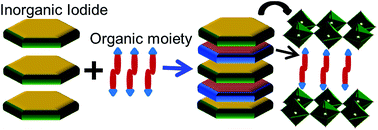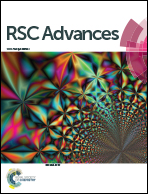Formation of PbO hexagonal nanosheets and their conversion into luminescent inorganic–organic perovskite nanosheets: growth and mechanism†
Abstract
We report the formation of inorganic–organic (IO) hybrid perovskite (C6H9C2H4NH3)2 PbI4 hexagonal nanosheets, using anisotropically grown PbO hexagonal nanosheets as a parent material. In place of the conventional chemical synthesis route, the PbO hexagonal nanosheets have been synthesized by the bottom-up electrochemical deposition technique. Conversion of PbO into the desired hybrid material has been achieved by the intercalation of organic moieties into the alternate layers of inorganic networks. These hybrid structures have shown strong room-temperature excitonic emission at 518 nm. An extensive study has been performed to observe the deposition parameters responsible for the growth of a well-defined hexagonal nanosheet. High-resolution transmission electron microscope results confirmed the growth of single crystalline hexagonal nanosheets in (110) plane orientation. Investigation of the surface morphology, further verified the formation of nanosheets with a smooth surface having an average roughness of 2 nm. The study revealed that the anisotropic growth of nanosheets is a result of different growth rates of crystal faces associated with the crystal lattice.


 Please wait while we load your content...
Please wait while we load your content...